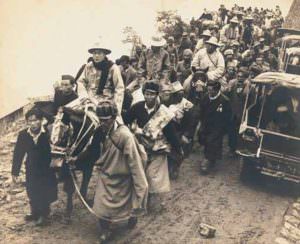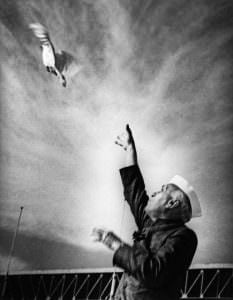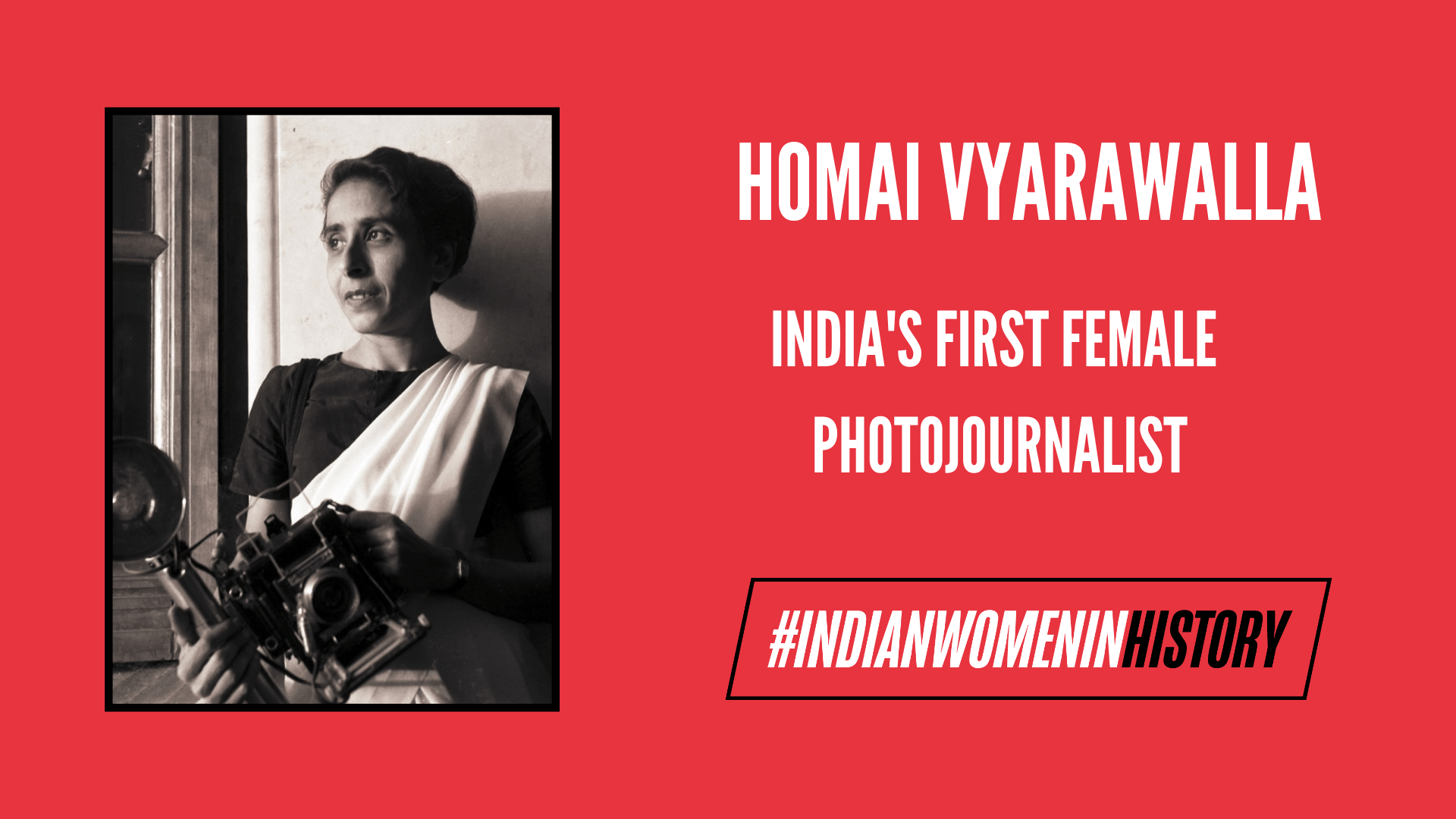The woman, who in her attempts to document Indian history, unknowingly became an unforgettable part of it.
The first few decades of the 20th century were a period where India was undergoing rather phenomenal changes that would lead to the culmination of over 200 years of colonial Raj. It was also a time when women were restricted to the private sphere, seldom being offered the luxury to gain access to education and participate in public life. The Indian freedom struggle saw a significant number of women become key crusaders of the movement for an independent India. In the midst of it all, one woman dared to enter a field dominated by men, and is now remembered as India’s first female photojournalist; the first lady behind the lens.
Early Life
Born to a Parsi family in Navsari, Gujarat on 9th December, 1913, Homai Hathiram spent her initial years in Vyara near Surat. Upon her family’s move to Tardeo, Mumbai (Bombay, as it was then known), Homai went on to complete her education with an Honors Degree from Bombay University. Coming from a middle class Parsi family, education was a sought-after goal for Homai, even though the social prejudices and barriers prevalent in those times stood in the way of women gaining access to the same. There were only six or seven other girls in school with Homai and she was the only girl among 36 students to complete her matriculation.
My mother would give me all kinds of home preparations to reduce my periods and I would gulp those down, but I had my own agenda and she didn’t know that. I would adjust my periods according to my school schedule.
-Homai Vyarawalla
Homai’s parents, Dossabhai and Soonabhai Hathiram, were not too educated themselves but were keen on her learning English and enrolled her in the Grant Road High School in Tardeo. Homai’s attempts to educate herself were met with several barriers – both social and others. Owing to the poor financial condition of her family, Homai often shifted houses and would travel long distances to get to school. Owing to her Parsi roots, Homai, like all other girls of her community, had to experience extreme stigma during her menstrual periods, living in seclusion for the duration of it, which prevented her from going to school. After completing her matriculation, Homai went on to study further at St. Xavier’s College, obtaining a degree in Economics.

Homai Vyarawalla, India’s First Female Journalist. Source: http://www.thebetterindia.com
Introduction to Photography
It was at a railway station that Homai first met Maneckshaw Vyarawalla in 1926 – the man who introduced her to the art of photography and continued to be an influential presence in her works. Though Homai primarily relied on Maneckshaw for picking up skills in photography, she also received formal training and at the same time completed a Diploma from the J.J School of Arts. The two initially shared Maneckshaw’s Rollieflex, developing their own films in a dark bathroom. Homai married Maneckshaw in 1941 – a decision that did not go down well with Maneckshaw’s mother.
In those days, orthodox people did not want college-educated girls for their sons. Especially those who had studied with boys.
-Homai Vyarawalla
Career as a Photojournalist
Homai began her career in photography as an assistant to Maneckshaw, who had been working with The Illustrated Weekly of India and The Bombay Chronicle. In fact, some of her earlier works were published under the name of Maneckshaw Vyarawalla owing to the lack of approval for women as professional photographers. Homai’s initial works focused primarily on everyday life in Bombay, capturing the day-to-day activities of urban women. Fondly referred to by her pseudonym “Dalda 13” (she considered the number 13 as lucky having been born in 1913 and having met her husband at the age of 13), Homai captured the essence of the emotions of her subjects in a manner no one else did.

The Dalai Lama riding into India in 1956. Credit Homai Vyarawalla, via Alkazi Collection of Photography
The outbreak of the Second World War and the events that followed gave Homai several opportunities to capture its political consequences in India. The war had resulted in bringing women out of their homes and into the public domain, where they became key agents of change, particularly post-Independence. Homai’s pictures from the time featured both British and Parsi women in their public avatars.
The war also resulted in Homai’s permanent ouster from Bombay. Homai and Maneckshaw Vyarawalla moved to Delhi with him in 1942, a move that would go on to be her initiation into public life as a photojournalist. The two began work with the British High Commission marking a significant step in Homai Vyarawalla’s career, for her stint with the High Commission made her regular at all events, public and private, marking the start of her golden period as a photo journalist.
In a post-war era, Homai was to move out of Bombay forever and be catapulted into the most public and political arenas, that of Delhi in the years leading unto 1947. Not only was this Westernized Parsi Woman, who worked for the British, to switch to Khadi Saris, but she was to become one of the most significant chroniclers of Independence through her images.
– Sabeena Gadihoke, Author of Camera Chronicles of Homai Vyarawalla
The Golden Period
Homai Vyarawalla was at the peak of her career at a time when the events that would go on to define the contours of 20th century history were taking place. The social and political context within which Homai Vyarawalla was making her presence felt is, therefore, all the more significant in understanding her contribution to Indian History. Owing the political scenario surrounding the initial phases of her career, Homai was one of the key agents of documenting the change that was being experienced in the era of post-independence, chronicling the emotions associated with the birth of an independent India and the ushering in of a new phase postcolonial rule.
Always dressed impeccably in a saree, with her Rolliflex camera by her side, Homai Vyarawalla’s humble and demure persona present at every significant event or soiree, documenting historical events and capturing eminent personalities – the likes of which included Jaqueline Kennedy, Queen Elizabeth, and Eisenhower. Homai’s fondness, however, lay in capturing India’s first Prime Minister, Pandit Jawaharlal Nehru, a man she thought was extremely photogenic, a fact that was known to one and all. She never shied away from acknowledging her favourite subject, chronicling some of the greatest moments of his political career and personal life including, his initiation into Prime Ministership, moments from social soirees, parties at the Delhi Gymkhana Club, the era of the non-alignment movement; and the Bandung Conference in 1955.

Jawaharlal Nehru releasing a dove, as captured by Homai Vyarawalla in the 1950s. Source: Time
When Nehru died, I felt like a child losing its favorite toy, and I cried, hiding my face from other photographers.
-Homai Vyarawalla
For a woman who was so closely associated with every public event the nation witnessed, Homai Vyarawalla did not let the backdrop of her professional environment weigh down on her personality. Her personal life was rather aloof from her social life. Her husband and her never went out much and Maneckshaw Vyarawalla kept himself absorbed in work. Homai, on the other hand enjoyed the outdoors, using her photography as medium to get out on the streets. She took pride in anonymity, never making her encounters with globally renowned persons be the defining elements of her life. She chose to speak through her effortless yet awe-inspiring photographs capturing human emotion in a series of black and white, a style she was particularly drawn to.
Some of the most significant highlights of her career include photographing the Reception hosted by Lord Mountbatten at the Rashtrapati Bhavan on August 15th 1947, the meeting of the Congress resulting in the Third Plan; the decision for partition, the first flag hoisting at the Red Fort, Mahatma Gandhi’s funeral, the photograph of the Dalai Lama entering India for the first time through Sikkim in 1956.

Jaqueline Kennedy feeding Urvashi, the baby Elephant, as captured by Homai Vyarawalla.
However, Homai Vyarawalla’s professional achievements and successes did not come easy. India was still struggling to find its footing. The social order although evolving post-Independence, hadn’t let go of the strong patriarchal values that would stand in the way of woman trying to do what was primarily seen as a man’s job. Her work was often overshadowed by her male contemporaries and even when she did get published in the initial years, she did not get due recognition for trying to make her mark in a male-dominated space. Her first shot published in the Bombay Chronicle in 1930 was that of a picnic party of members of the Women’s Club in Bombay, and was published under Maneckshaw Vyarawalla’s name.
The End of an Era
It was through her close association with Maneckshaw whom she married in 1941, that Homai developed an interest in photography in the 1930s. He had a great bearing on her choices both professional and personal. They had a companionship that lasted over forty years and it was probably the same reason that after the death of her husband Maneckshaw in 1969, Homai lost her passion for photography and moved to Pilaniwith her son Farouq. Homai spent the final two decades of her life in Vadodara, choosing to lead a life of seclusion and anonymity. Her life in Pilani and Vadhodhra was simplistic; giving her the time to indulge in activities she did not have the chance or time for earlier. She also found joy in the company of women, something she hadn’t experienced earlier owing to her lack of connection with them.
I was afraid of being with women. I only heard them talk of maid-servants, Jewellery and make-up that I could never relate to. My world was so different. It was in Pilani that I understood women can be good friends too and I shouldn’t be afraid of them.
-Homai Vyarawalla
Homai Vyarawalla, the woman that captured the soul of the nation, in the moments of its birth, breathed her last on 15th January 2012. She has been giving several recognitions and awards including the second highest civilian honour in India, the Padma Vibhushan in 2011. Her collection of photographs is now in possession of the Alkazi Foundation for the Arts and the National Gallery of Modern Art, New Delhi.
References
- India in Focus: Camera Chronicles of Homai Vyarawalla – Sabeena Gadihoke
- Homai Vyarawalla: India’s First Female Journalist – Time.com
- Homai Vyarawalla – Brittanica Encyclopedia
About the author(s)
Graduate from Lady Sri Ram College & Faculty of Law, University of Delhi. Currently working as a Law Researcher at the High Court Of Delhi.





https://www.facebook.com/pg/ewomen.co/videos/?ref=page_internal
This is an outstanding video about homai vyrawalla lifestory!
https://www.facebook.com/ewomen.co/videos/363685790749731/